Physicochemical and Mineralogical Characterizations of Two Natural Laterites from Burkina Faso: Assessing Their Potential Usage as Adsorbent Materials
Abstract
1. Introduction
2. Materials and Methods
2.1. Origin of Samples
2.2. The Specific Geological Contexts of the Sites
2.2.1. Geological Context of the Northern Kaya Site
2.2.2. Geological Context of the Laye Site
2.3. Raw Material Characterization
2.3.1. Chemical Composition
2.3.2. Infrared Spectroscopy
2.3.3. X-Ray Powder Diffraction (XRD)
2.3.4. Semi-Quantification
- ▪
- Alumina is distributed in kaolinite;
- ▪
- Iron oxide is distributed between goethite and hematite;
- ▪
- Silicon oxide is distributed between quartz and kaolinite.
2.3.5. Differential Scanning Calorimetry (DSC) and Thermogravimetric Analysis (TGA)
2.3.6. Zeta Potential Measurements
2.3.7. Specific Surface Area and Porosity by Nitrogen Sorption Analysis
2.4. Cation Exchange Capacity (CEC)
2.5. Anionic Exchange Capacity (AEC)
2.6. Experimental Studies on Arsenic and Heavy Metal Ion Removal
3. Results and Discussion
3.1. Chemical Composition
3.2. Mineralogical Characterization
3.2.1. X-Ray Diffraction (XRD)
3.2.2. Semi-Quantification
3.2.3. Infrared Spectrometry (IR)
3.3. Thermogravimetric Analysis and Differential Scanning Calorimetry (TGA /DSC)
3.4. Specific Surface Area and Porosity Using Nitrogen Sorption Analysis
3.5. Determination of Anionic Exchange Capacity (AEC)
3.6. Determination of Cation Exchange Capacity (CEC)
| Adsorbents | C.E.C (cmol(+)/kg) | References |
|---|---|---|
| Clay mineral | 42.38 | [58] |
| Peat soil | 33–48 | [59] |
| Bauxite | 24–33 | [59] |
| Iron concretion | 59–65 | [59] |
| Natural clay | 18.66 | [60] |
| Kaolinite | 13.00 | [61] |
| Bentonitic clay | 67.00 | [62] |
| Ivory Coast clay | 35.47 | [63] |
| Laterite soil (KN) | 52.33 | This study |
| Laterite soil (LA) | 58.70 |
3.7. Isoelectric Point (IP) of Laterite Samples
3.8. Batch Adsorption Experiments: Application to Arsenic (III, V) and Pb(II) and Cu(II) Removal
3.9. A Comparison of the Main Physicochemical Properties Related to the Adsorption of Laterites from Burkina Faso with Those Reported in the Literature
4. Conclusions
Author Contributions
Funding
Data Availability Statement
Acknowledgments
Conflicts of Interest
References
- Ndiaye, M.; Magnan, J.P.; Cissé, I.K.; Cissé, L. Étude de l’amélioration de latérites du Sénégal par ajout de sable. Bull. Lab. Ponts Chaussees 2013, 280, 123–137. [Google Scholar]
- Ouedraogo, R.D.; Bakouan, C.; Sorgho, B.; Guel, B.; Bonou, L.D. Characterization of a natural laterite of Burkina Faso for the elimination of arsenic (III) and arsenic (V) in groundwater. Int. J. Biol. Chem. Sci. 2019, 13, 2959–2977. [Google Scholar] [CrossRef]
- Najar, M.; Sakhare, V.; Karn, A.; Chaddha, M.; Agnihotri, A. A study on the impact of material synergy in geopolymer adobe: Emphasis on utilizing overburden laterite of aluminium industry. Open Ceram. 2021, 7, 100163. [Google Scholar] [CrossRef]
- Lawane, A.; Pantet, A.; Vinai, R.; Hugues, J. Etude géologique et géomécanique des latérites de Dano (Burkina Faso) pour une utilisation dans l’habitat, XXIXe Recontres Univ. Genie Civ. 2011, 86, 206–215. [Google Scholar]
- Bourman, R.P.; Ollier, C.D. A critique of the Schellmann definition and classification of laterite. Catena 2002, 47, 117–131. [Google Scholar] [CrossRef]
- Maiti, A.; Thakur, B.K.; Basu, J.K.; De, S. Comparison of treated laterite as arsenic adsorbent from different locations and performance of best filter under field conditions. J. Hazard. Mater. 2013, 262, 1176–1186. [Google Scholar] [CrossRef] [PubMed]
- Huang, W.Y.; Zhu, R.H.; He, F.; Li, D.; Zhu, Y.; Zhang, Y.M. Enhanced phosphate removal from aqueous solution by ferric-modified laterites: Equilibrium, kinetics and thermodynamic studies. Chem. Eng. J. 2013, 228, 679–687. [Google Scholar] [CrossRef]
- Nguyen, T.H.; Tran, H.N.; Vu, H.A.; Trinh, M.V.; Nguyen, T.V.; Loganathan, P.; Vigneswaran, S.; Nguyen, T.M.; Trinh, V.T.; Vu, D.L.; et al. Laterite as a low-cost adsorbent in a sustainable decentralized filtration system to remove arsenic from groundwater in Vietnam. Sci. Total Environ. 2020, 699, 134267. [Google Scholar] [CrossRef]
- Nguyena, T.H.; Nguyen, A.T.; Loganathan, P.; Nguyen, T.V.; Vigneswaran, S.; Nguyen, T.H.H.; Trand, H.N. Low-cost laterite-laden household filters for removing arsenic from groundwater in Vietnam and waste management. Process Saf. Environ. Prot. 2021, 152, 154–163. [Google Scholar] [CrossRef]
- Thanakunpaisit, N.; Jantarachat, N.; Onthong, U. Removal of Hydrogen Sulfide from Biogas using Laterite Materials as an Adsorbent. Energy Procedia 2017, 138, 1134–1139. [Google Scholar] [CrossRef]
- Kamagate, M.; Assadi, A.A.; Kone, T.; Giraudet, S.; Coulibaly, L.; Hanna, K. Use of laterite as a sustainable catalyst for removal of fluoroquinolone antibiotics from contaminated water. Chemosphere 2018, 195, 847–853. [Google Scholar] [CrossRef] [PubMed]
- Karki, S.; Timalsina, H.; Budhathoki, S.; Budhathoki, S. Arsenic removal from groundwater using acid-activated laterite. Groundw. Sustain. Dev. 2022, 18, 100769. [Google Scholar] [CrossRef]
- Millogo, Y.; Traoré, K.; Ouedraogo, R.; Kaboré, K.; Blanchart, P.; Thomassin, J.H. Geotechnical, mechanical, chemical and mineralogical characterization of a lateritic gravels of Sapouy (Burkina Faso) used in road construction. Constr. Build. Mater. 2008, 22, 70–76. [Google Scholar] [CrossRef]
- Lawane, A.; Vinai, R.; Pantet, A.; Thomassin, J.-H.; Messan, A. Hygrothermal Features of Laterite Dimension Stones for Sub-Saharan Residential Building Construction. J. Mater. Civ. Eng. 2014, 26, 05014002. [Google Scholar] [CrossRef]
- Maji, S.K.; Pal, A.; Pal, T.; Adak, A. Adsorption Thermodynamics of Arsenic on Laterite Soil. J. Surf. Sci. Technol. 2007, 22, 161–176. [Google Scholar]
- Maiti, A.; Dasgupta, S.; Basu, J.; De, S. Adsorption of arsenite using natural laterite as adsorbent. Sep. Purif. Technol. 2007, 55, 350–359. [Google Scholar] [CrossRef]
- Kadam, A.M.; Nemade, P.D.; Oza, G.H.; Shankar, H.S. Treatment of municipal wastewater using laterite-based constructed soil filter. Ecol. Eng. 2009, 35, 1051–1061. [Google Scholar] [CrossRef]
- Xu, D.; Tan, X.L.; Chen, C.L.; Wang, X.K. Adsorption of Pb(II) from aqueous solution to MX-80 bentonite: Effect of pH, ionic strength, foreign ions and temperature. Appl. Clay Sci. 2008, 41, 37–46. [Google Scholar] [CrossRef]
- Eren, E.; Afsin, B. An investigation of Cu(II) adsorption by raw and acid-activated bentonite: A combined potentiometric, thermodynamic, XRD, IR, DTA study. J. Hazard. Mater. 2008, 151, 682–691. [Google Scholar] [CrossRef]
- Melichová, Z.; Hromada, L. Adsorption of Pb2+ and Cu2+ Ions from Aqueous Solutions on Natural Bentonite, Polish. J. Environ. Stud. 2012, 22, 457–464. [Google Scholar]
- Moutou, J.M.; Foutou, P.M.; Matini, L.; Samba, V.B.; Mpissi, Z.F.D.; Loubaki, R. Characterization and Evaluation of the Potential Uses of Mouyondzi Clay. J. Miner. Mater. Charact. Eng. 2018, 06, 119–138. [Google Scholar] [CrossRef][Green Version]
- Maiti, A.; DasGupta, S.; Basu, J.K.; De, S. Batch and Column Study: Adsorption of Arsenate Using Untreated Laterite as Adsorbent. Ind. Eng. Chem. Res. 2008, 47, 1620–1629. [Google Scholar] [CrossRef]
- Ghani, U.; Hussain, S.; Amin, N.U.; Imtiaz, M.; Khan, S.A. Laterite clay-based geopolymer as a potential adsorbent for the heavy metals removal from aqueous solutions. J. Saudi Chem. Soc. 2020, 24, 874–884. [Google Scholar] [CrossRef]
- He, F.; Ma, B.; Wang, C.; Chen, Y.; Hu, X. Adsorption of Pb(II) and Cd(II) hydrates via inexpensive limonitic laterite: Adsorption characteristics and mechanisms. Sep. Purif. Technol. 2023, 310, 123234. [Google Scholar] [CrossRef]
- Mitra, S.; Thakur, L.S.; Rathore, V.K.; Mondal, P. Removal of Pb(II) and Cr(VI) by laterite soil from synthetic waste water: Single and bi-component adsorption approach. Desalin. Water Treat. 2016, 57, 18406–18416. [Google Scholar] [CrossRef]
- Mohapatra, M.; Khatun, S.; Anand, S. Kinetics and thermodynamics of lead (II) adsorption on lateritic nickel ores of Indian origin. Chem. Eng. J. 2009, 155, 184–190. [Google Scholar] [CrossRef]
- Zhu, D.; He, Y.; Zhang, B.; Zhang, N.; Lei, Z.; Zhang, Z.; Chen, G.; Shimizu, K. Simultaneous removal of multiple heavy metals from wastewater by novel plateau laterite ceramic in batch and fixed-bed studies. J. Environ. Chem. Eng. 2021, 9, 105792. [Google Scholar] [CrossRef]
- Ouedraogo, R.D.; Bakouan, C.; Sakira, A.K.; Sorgho, B.; Guel, B.; Somé, T.I.; Hantson, A.L.; Ziemons, E.; Mertens, E.; Hubert, P.; et al. The Removal of As(III) Using a Natural Laterite Fixed-Bed Column Intercalated with Activated Carbon: Solving the Clogging Problem to Achieve Better Performance. Separations 2024, 11, 129. [Google Scholar] [CrossRef]
- Koffi, Y.H.; Wenmenga, U.; Djro, S.C. Tarkwaian Deposits of the Birimian Belt of Houndé: Petrological, Structural and Geochemical Study (Burkina-Faso, West Africa). Int. J. Geosci. 2016, 7, 685–700. [Google Scholar] [CrossRef]
- Njopwouo, D.; Orliac, M. Note sur le comportement de certains minéraux à l’attaque triacide. Cah. ORSTOM Sér. Pédol. 1979, 17, 329–337. [Google Scholar]
- Laibi, A.B.; Gomina, M.; Sorgho, B.; Sagbo, E.; Blanchart, P.; Boutouil, M.; Sohounhloule, D.K.C. Caractérisation physico-chimique et géotechnique de deux sites argileux du Bénin en vue de leur valorisation dans l’éco-construction. Int. J. Biol. Chem. Sci. 2017, 11, 499–514. [Google Scholar] [CrossRef]
- Zelazny, L.W.; He, L. Chapter 41 Charge Analysis of Soils and Anion Exchange. In Methods of Soil Analysis: Part 3 Chemical Methods—SSSA Book Series; Sparks, D.L., Page, A.L., Helmke, P.A., Loeppert, R.H., Soltanpour, P.N., Tabatabai, M.A., Johnston, C.T., Sumner, M.E., Eds.; Wiley: Hoboken, NJ, USA, 1996; Volume 5, pp. 1231–1253. [Google Scholar] [CrossRef]
- Konan, K.L. Interactions Entre des Matériaux Argileux et un Milieu Basique Riche en Calcium. Ph.D. Thesis, Université de Limoge, Limoges, France, 2006; pp. 1–144. [Google Scholar]
- Mbumbia, L.; De Wilmars, A.M.; Tirlocq, J. Performance characteristics of lateritic soil bricks fired at low temperatures: A case study of Cameroon. Constr. Build. Mater. 2000, 14, 121–131. [Google Scholar] [CrossRef]
- Nemade, P.D.; Kadam, A.M.; Shankar, H.S.; Bengal, W. Adsorption of arsenic from aqueous solution on naturally available red soil. J. Environ. Biol. 2009, 30, 499–504. [Google Scholar]
- Maiti, A.; Basu, J.K.; De, S. Experimental and kinetic modeling of As(V) and As(III) adsorption on treated laterite using synthetic and contaminated groundwater: Effects of phosphate, silicate and carbonate ions. Chem. Eng. J. 2012, 191, 1–12. [Google Scholar] [CrossRef]
- Glocheux, Y.; Pasarín, M.M.; Albadarin, A.B.; Allen, S.J.; Walker, G.M. Removal of arsenic from groundwater by adsorption onto an acidified laterite by-product. Chem. Eng. J. 2013, 228, 565–574. [Google Scholar] [CrossRef]
- Partey, F.; Norman, D.; Ndur, S.; Nartey, R. Arsenic sorption onto laterite iron concretions: Temperature effect. J. Colloid Interface Sci. 2008, 321, 493–500. [Google Scholar] [CrossRef]
- Jahan, N.; Guan, H.; Bestland, E.A. Arsenic remediation by Australian laterites. Environ. Earth Sci. 2011, 64, 247–253. [Google Scholar] [CrossRef]
- Joussein, E.; Petit, S.; Decarreau, A. Une nouvelle méthode de dosage des minéraux argileux en mélange par spectroscopie IR. Comptes Rendus L’académie Sci.-Ser. IIA-Earth Planet. 2001, 332, 83–89. [Google Scholar] [CrossRef]
- Lakshmipathiraj, P.; Narasimhan, B.R.V.; Prabhakar, S.; Raju, G.B. Adsorption of arsenate on synthetic goethite from aqueous solutions. J. Hazard. Mater. 2006, 136, 281–287. [Google Scholar] [CrossRef]
- Madejová, J. FTIR techniques in clay mineral studies. Vib. Spectrosc. 2003, 31, 1–10. [Google Scholar] [CrossRef]
- ALzaydien, A.S. Adsorption of methylene blue from aqueous solution onto a low-cost natural Jordanian Tripoli. Am. J. Appl. Sci. 2009, 6, 1047–1058. [Google Scholar] [CrossRef]
- Kloprogge, J.T.; Frost, R.L.; Hickey, L. Infrared emission spectroscopic study of the dehydroxylation of some hectorites. Thermochim. Acta 2000, 345, 145–156. [Google Scholar] [CrossRef]
- Ristić, M.; Musić, S.; Godec, M. Properties of γ-FeOOH, α-FeOOH and α-Fe2O3 particles precipitated by hydrolysis of Fe3+ ions in perchlorate containing aqueous solutions. J. Alloys Compd. 2006, 417, 292–299. [Google Scholar] [CrossRef]
- Chen, Y.F.; Wang, M.C.; Hon, M.H. Phase transformation and growth of mullite in kaolin ceramics. J. Eur. Ceram. Soc. 2004, 24, 2389–2397. [Google Scholar] [CrossRef]
- Sarkar, M.; Banerjee, A.; Pramanick, P.P.; Sarkar, A.R. Design and operation of fixed bed laterite column for the removal of fluoride from water. Chem. Eng. J. 2007, 1, 329–335. [Google Scholar] [CrossRef]
- Gallios, G.P.; Tolkou, A.K.; Katsoyiannis, I.A.; Stefusova, K.; Vaclavikova, M.; Deliyanni, E.A. Adsorption of arsenate by nano scaled activated carbon modified by iron and manganese oxides. Sustainability 2017, 9, 1684. [Google Scholar] [CrossRef]
- Sanou, Y.; Pare, S.; Nguyen, T.T.; Phuoc, N.V. Experimental and Kinetic modeling of As (V) adsorption on Granular Ferric Hydroxide and Laterite. J. Environ. Treat. Tech. 2016, 4, 62–70. [Google Scholar]
- Nguyen, P.T.N.; Abella, L.C.; Gaspillo, P.D.; Hinode, H. Removal of arsenic from simulated groundwater using calcined laterite as the adsorbent. J. Chem. Eng. Jpn. 2011, 44, 411–419. [Google Scholar] [CrossRef]
- Uddin, M.K. A review on the adsorption of heavy metals by clay minerals, with special focus on the past decade. Chem. Eng. J. 2017, 308, 438–462. [Google Scholar] [CrossRef]
- Cheng, C.H.; Lehmann, J.; Engelhard, M.H. Natural oxidation of black carbon in soils: Changes in molecular form and surface charge along a climosequence. Geochim. Cosmochim. Acta 2008, 72, 1598–1610. [Google Scholar] [CrossRef]
- Lawrinenko, M.; Laird, D.A. Anion exchange capacity of biochar. Green Chem. 2015, 17, 4628–4636. [Google Scholar] [CrossRef]
- Schell, W.R.; Jordan, J.V. Anion-exchange studies of pure clays. Plant Soil 1959, 10, 303–318. [Google Scholar] [CrossRef]
- Achour, S.; Youcef, L. Elimination du Cadmium Par Adsorption Sur Bentonites Sodique et Calcique. Larhyss J. 2003, 2, 68–81. [Google Scholar]
- Youcef, L.; Achour, S. Elimination du cuivre par des procédés de précipitation chimique et d’adsorption. Courr. Savoir 2006, 7, 59–65. [Google Scholar]
- Maji, S.K.; Pal, A.; Pal, T. Arsenic removal from real-life groundwater by adsorption on laterite soil. J. Hazard. Mater. 2008, 151, 811–820. [Google Scholar] [CrossRef]
- Sorgho, B.; Paré, S.; Guel, B.; Zerbo, L.; Traoré, K.; Persson, I. Etude d’une argile locale du Burkina Faso à des fins de décontamination en Cu2+, Pb2+ et Cr3+. J. Société Ouest-Africaine Chim. 2011, 31, 49–59. [Google Scholar]
- Alshaebi, F.Y.; Yaacob, W.Z.W.; Samsudin, A.R. Removal of arsenic from contaminated water by selected geological natural materials, Aust. J. Basic Appl. Sci. 2010, 4, 4413–4422. [Google Scholar]
- Ghorbel-Abid, I.; Galai, K.; Trabelsi-Ayadi, M. Retention of chromium (III) and cadmium (II) from aqueous solution by illitic clay as a low-cost adsorbent. Desalination 2010, 256, 190–195. [Google Scholar] [CrossRef]
- Tekin, N.; Kadinci, E.; Demirbaş, Ö.; Alkan, M.; Kara, A. Adsorption of polyvinylimidazole onto kaolinite. J. Colloid Interface Sci. 2006, 296, 472–479. [Google Scholar] [CrossRef]
- Ayari, F.; Srasra, E.; Trabelsi-Ayadi, M. Characterization of bentonitic clays and their use as adsorbent. Desalination 2005, 185, 391–397. [Google Scholar] [CrossRef]
- Kouadio, L.M.; Lebouachera, S.I.; Blanc, S.; Sei, J.; Miqueu, C.; Pannier, F.; Martinez, H. Characterization of Clay Materials from Ivory Coast for Their Use as Adsorbents for Wastewater Treatment. J. Miner. Mater. Charact. Eng. 2022, 10, 319–337. [Google Scholar] [CrossRef]
- Zhang, X.; Hong, H.; Li, Z.; Guan, J.; Schulz, L. Removal of azobenzene from water by kaolinite. J. Hazard. Mater. 2009, 170, 1064–1069. [Google Scholar] [CrossRef] [PubMed]
- Mostafapour, F.K.; Bazrafshan, E.; Farzadkia, M.; Amini, S. Arsenic Removal from Aqueous Solutions by Salvadora persica Stem Ash. J. Chem. 2013, 2013, 740847. [Google Scholar]
- Ayach, J.; Duma, L.; Badran, A.; Hijazi, A.; Martinez, A.; Bechelany, M.; Baydoun, E.; Hamad, H. Enhancing Wastewater Depollution: Sustainable Biosorption Using Chemically Modified Chitosan Derivatives for Efficient Removal of Heavy Metals and Dyes. Materials 2024, 17, 2724. [Google Scholar] [CrossRef] [PubMed]
- Khater, D.; Alkhabbas, M.; Al-Ma’abreh, A.M. Adsorption of Pb, Cu, and Ni Ions on Activated Carbon Prepared from Oak Cupules: Kinetics and Thermodynamics Studies. Molecules 2024, 29, 2489. [Google Scholar] [CrossRef]
- Chuang, Y.; Chen, J.; Lu, J.; Su, L.; Jiang, S.Y.; Zhao, Y.; Lee, C.H.; Wu, Z.; Ruan, H.D. Sorption studies of Pb(II) onto montmorillonite clay. IOP Conf. Ser. Earth Environ. Sci. 2022, 1087, 012007. [Google Scholar] [CrossRef]
- Pham, T.D.; Pham, T.T.; Phan, M.N.; Ngo, T.M.V.; Dang, V.D.; Vu, C.M. Adsorption characteristics of anionic surfactant onto laterite soil with differently charged surfaces and application for cationicdye removal. J. Mol. Liq. 2020, 301, 112456. [Google Scholar] [CrossRef]
- Rathore, V.K.; Dohare, D.K.; Mondal, P. Competitive adsorption between arsenic and fluoride from binary mixture on chemically treated laterite. J. Environ. Chem. Eng. 2016, 4, 2417–2430. [Google Scholar] [CrossRef]
- Chatterjee, S.; De, S. Application of novel, low-cost, laterite-based adsorbent for removal of lead from water: Equilibrium, kinetic and thermodynamic studies. J. Environ. Sci. Health—Part A Toxic/Hazard. Subst. Environ. Eng. 2016, 51, 193–203. [Google Scholar] [CrossRef]
- Bakouan, C. Caractérisation de Quelques Sites Latéritiques du Burkina Faso: Application à L’élimination de L’arsenic (III) et (V) Dans Les Eaux Souterraines. Ph.D. Thesis, Université de Ouaga I Pr Joseph KI-ZERBO, Ouagadougou, Burkina Faso, Université de Mons, Mons, Belgium, 2018; pp. 1–241. Available online: https://orbi.umons.ac.be/bitstream/20.500.12907/31806/1/Th%C3%A8se (accessed on 1 February 2018).
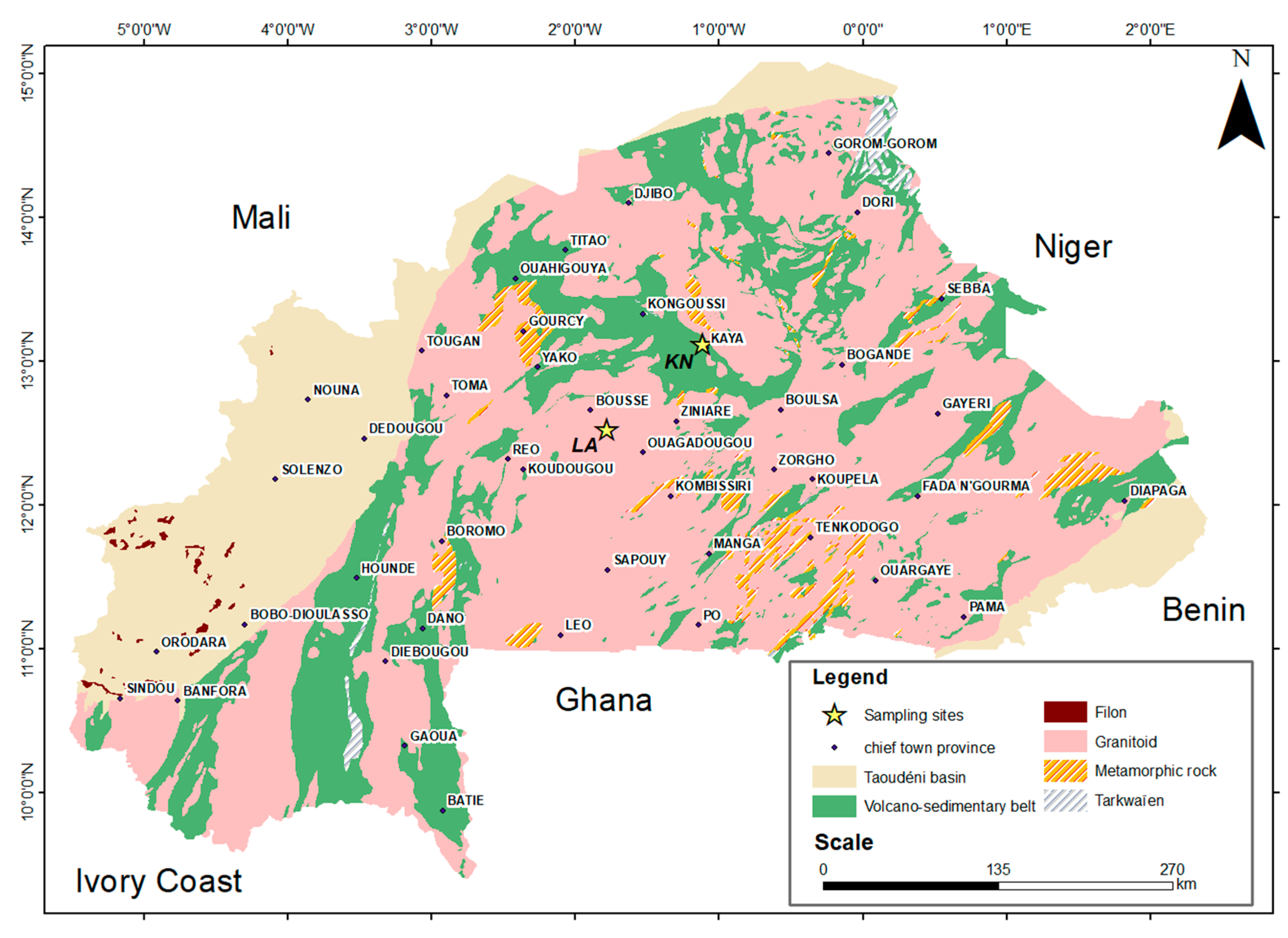
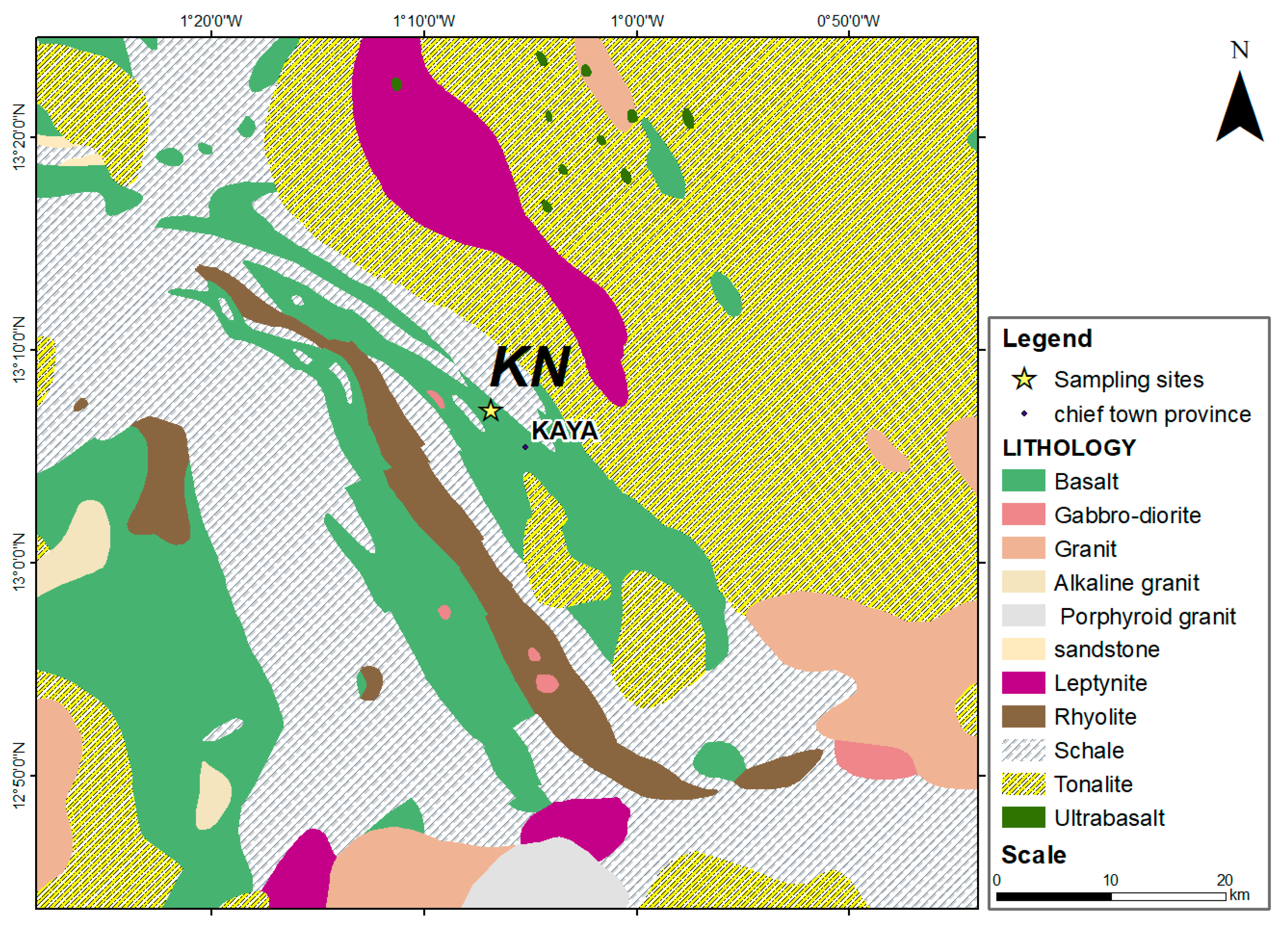
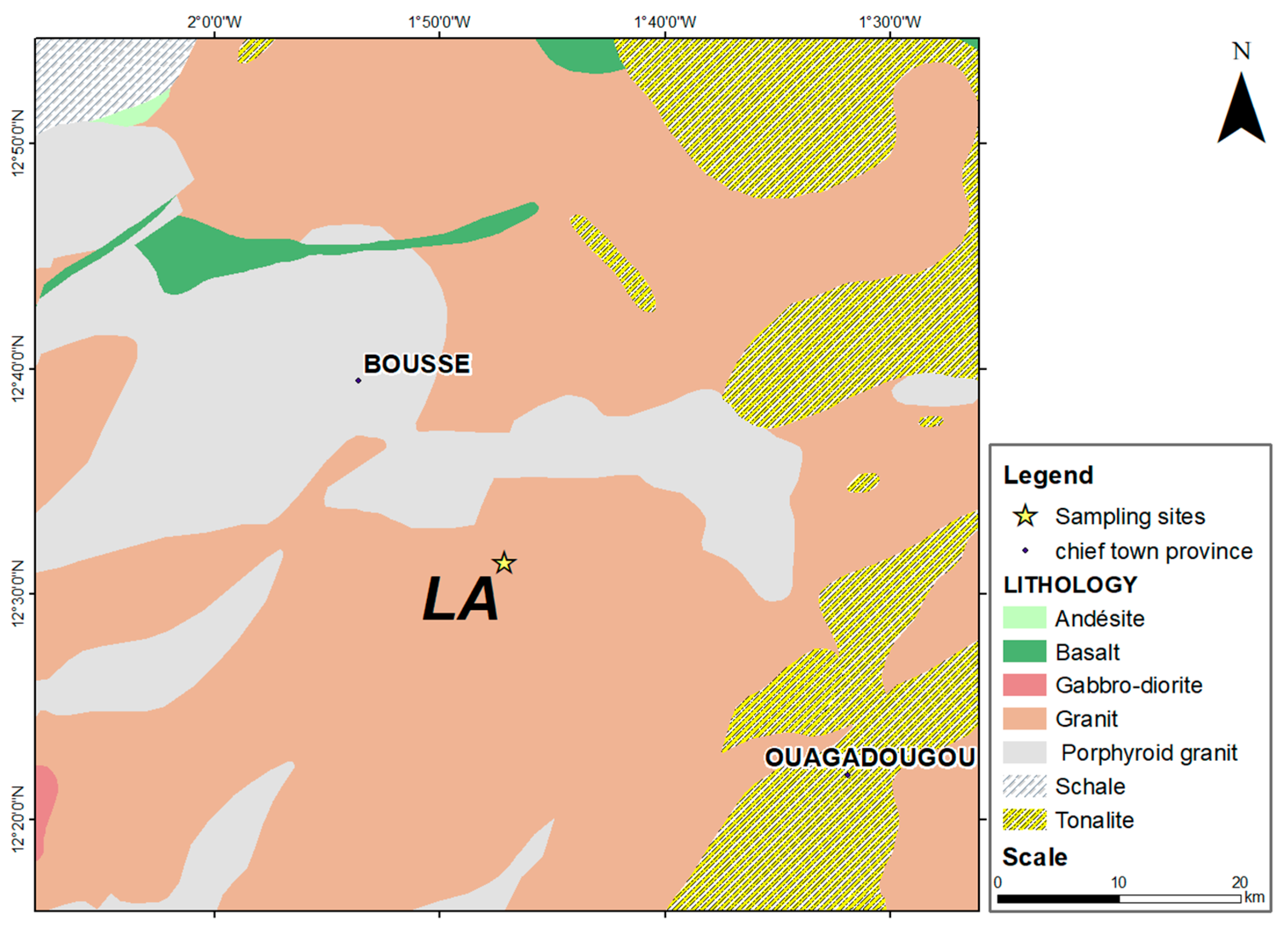
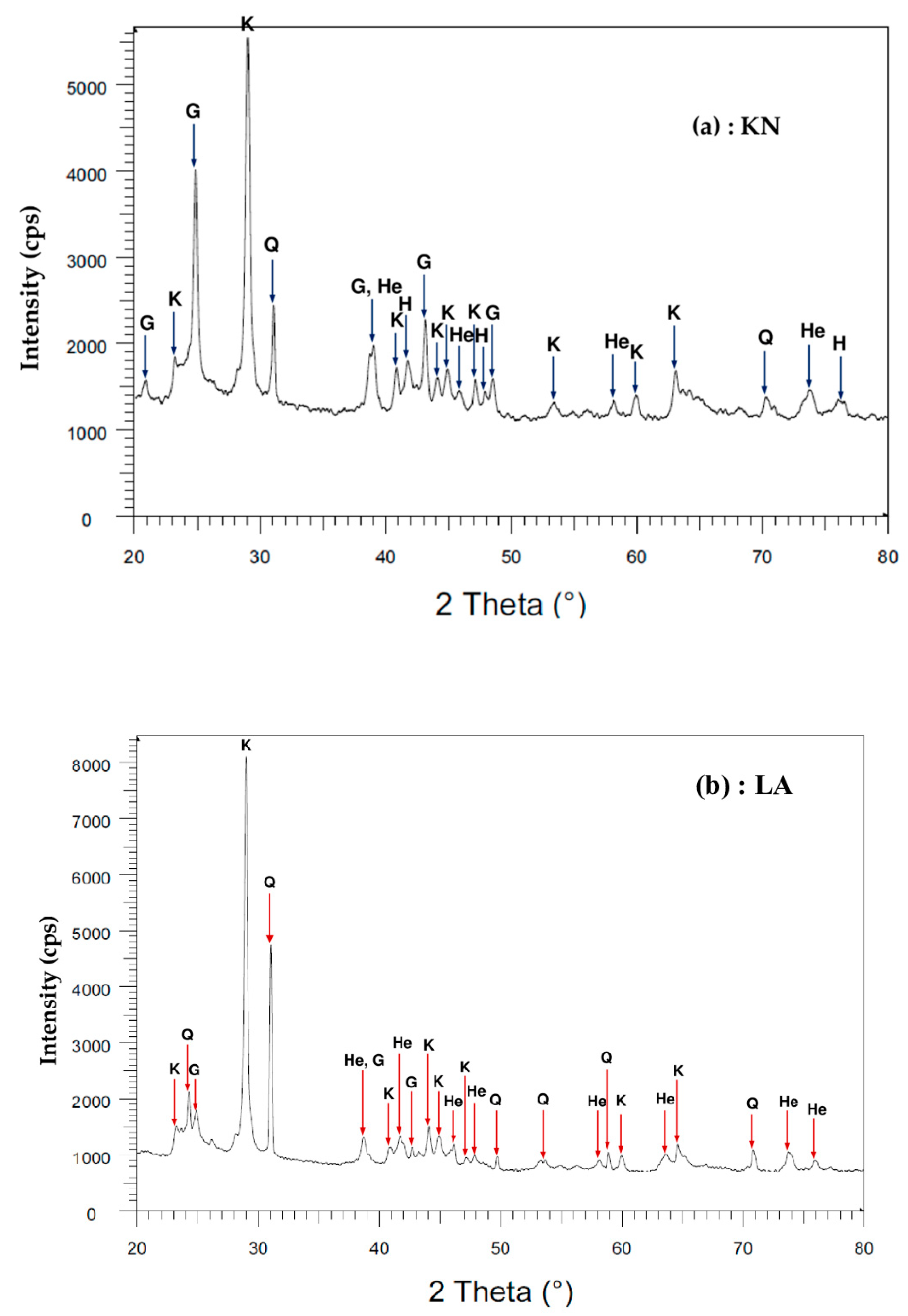
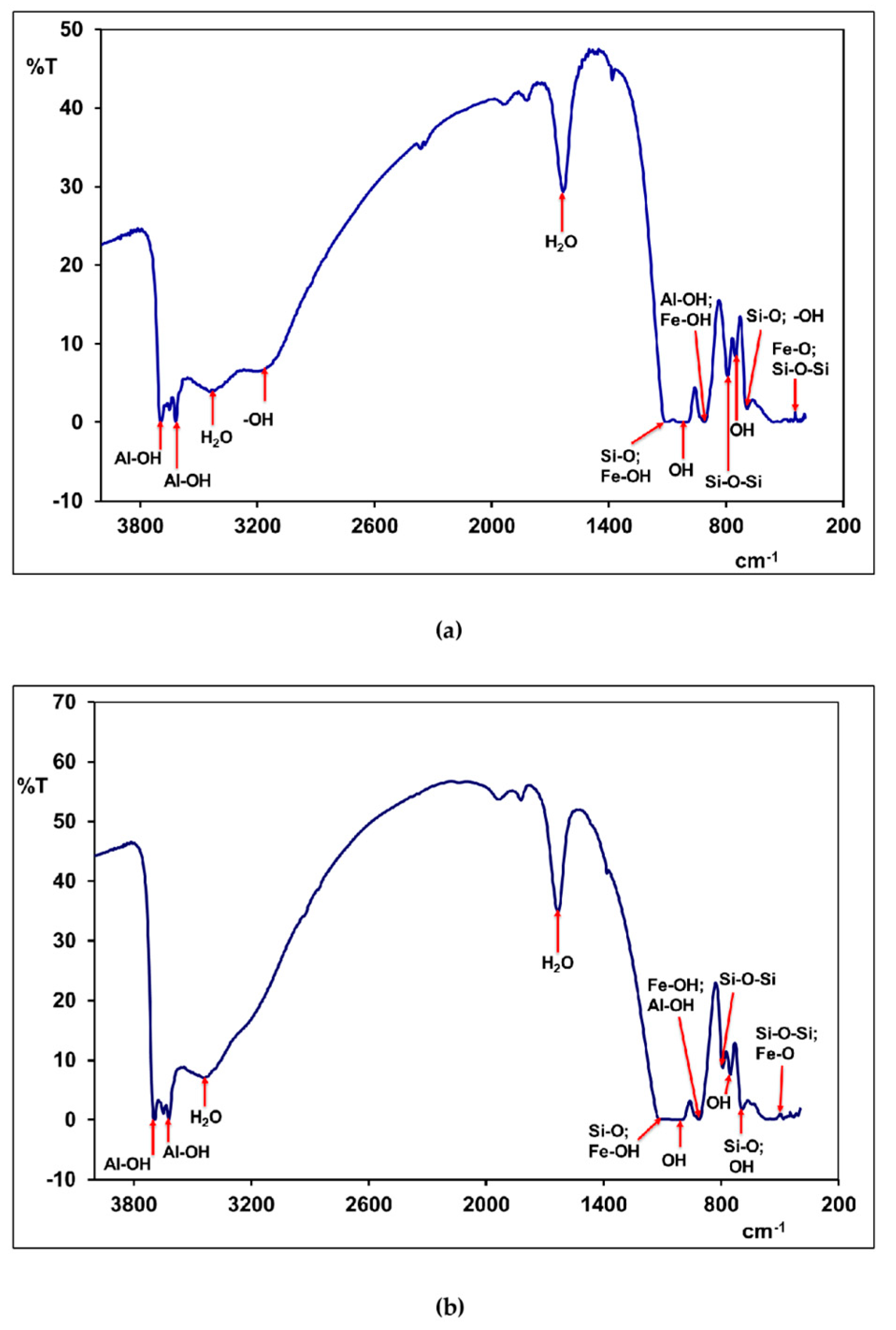
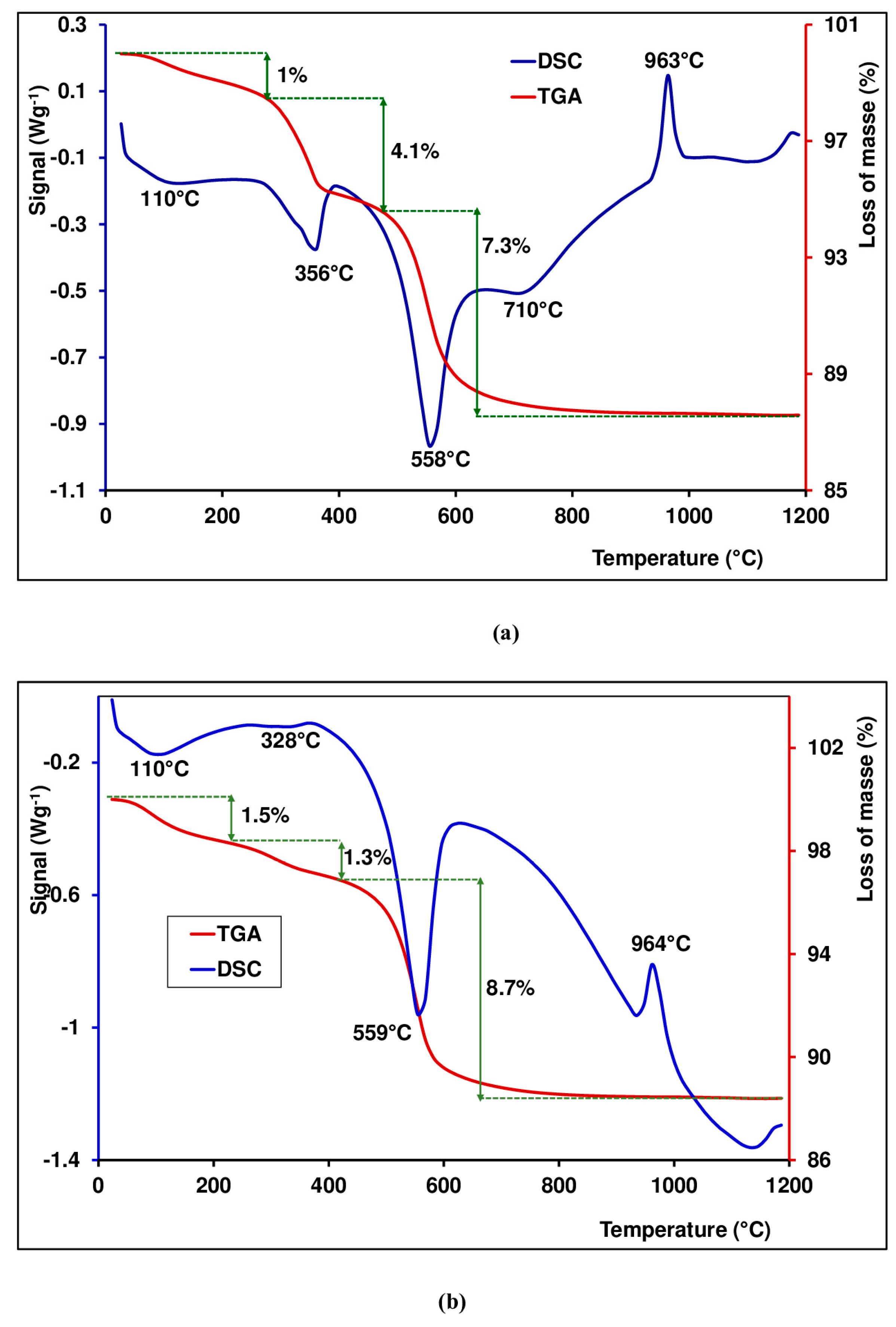
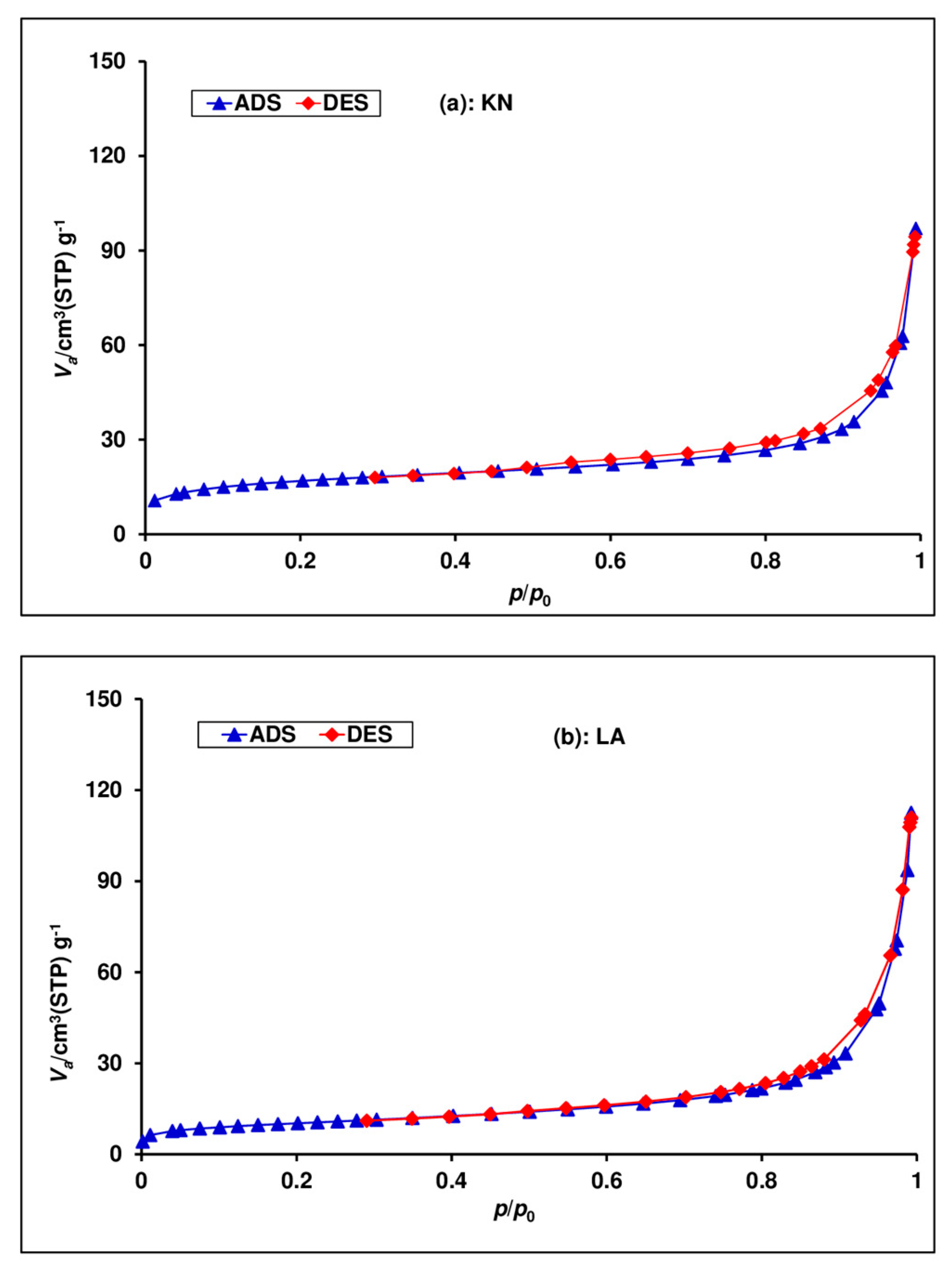
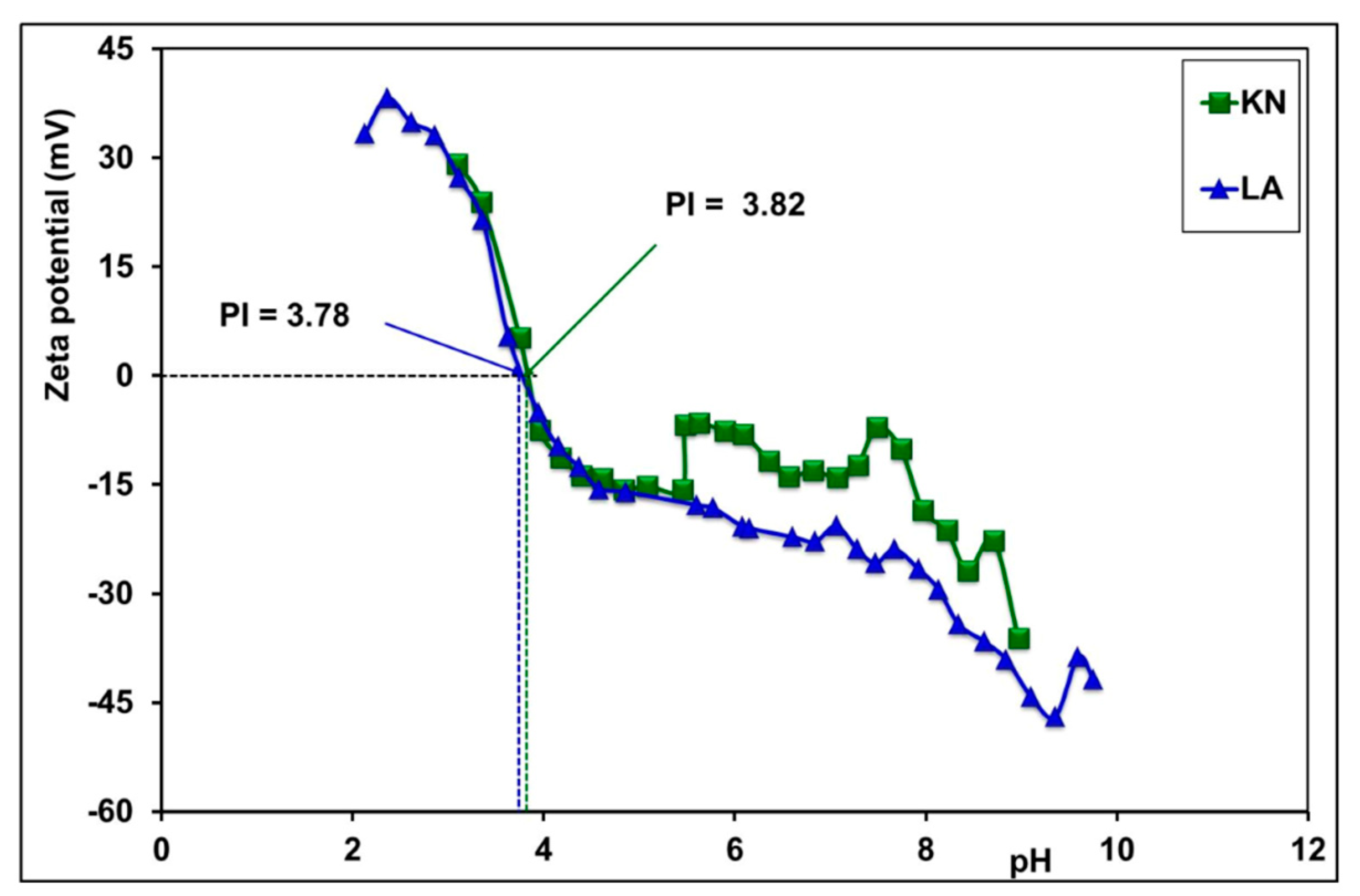
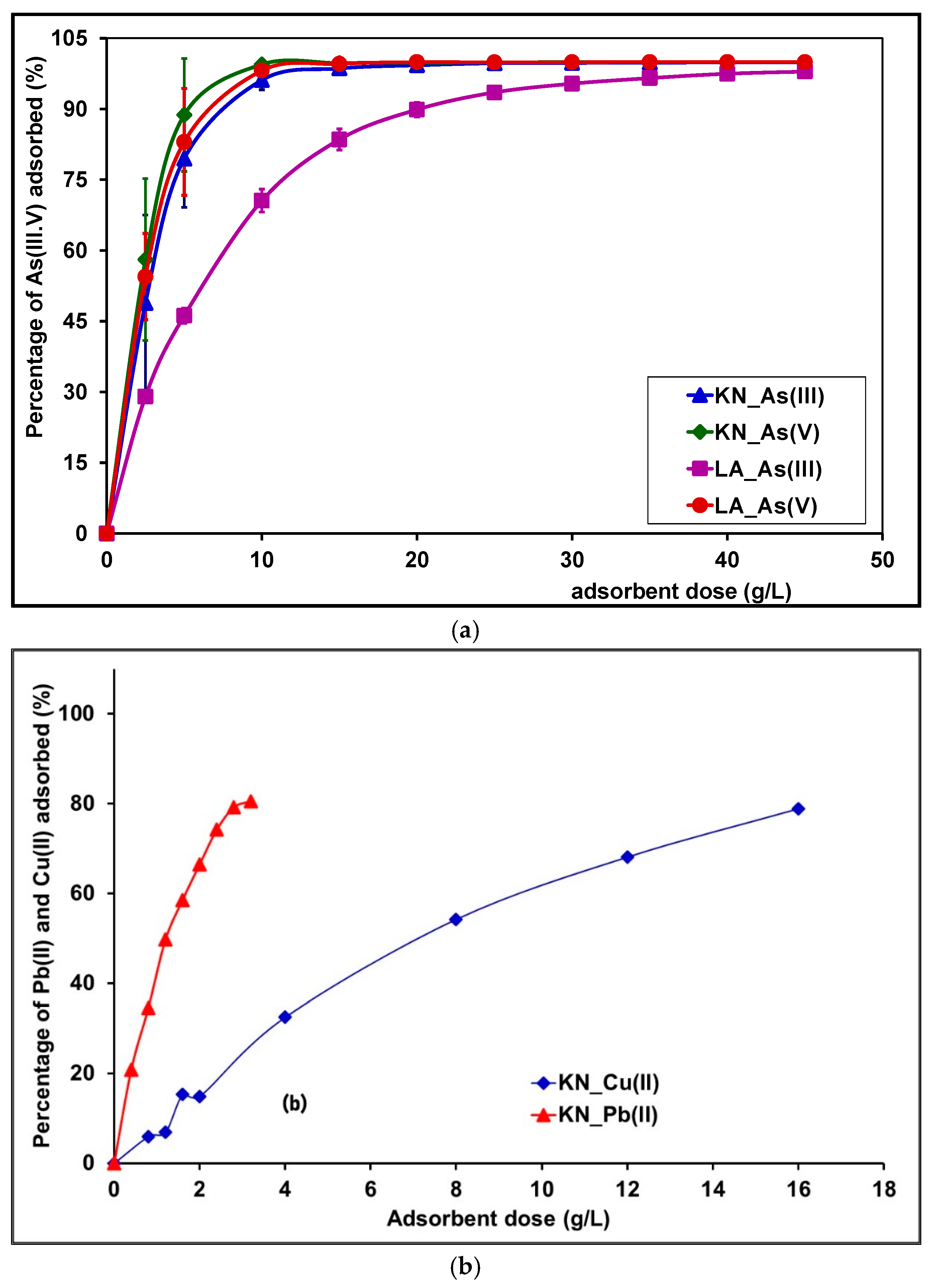
| Properties | KN | LA |
|---|---|---|
| Total organic carbon (TOC) (%) | 0.16 | 0.09 |
| Organic matter (OM) (%) | 0.73 | 1.32 |
| Apparent density | 2.9 | 2.6 |
| Inorganic composition (wt.%) | ||
| Fe2O3 | 20.8 | 17.65 |
| Al2O3 | 14.09 | 6.74 |
| SiO2 | 50.16 | 53.70 |
| K2O | 1.70 | 1.82 |
| Na2O | 1.43 | 1.40 |
| TiO2 | 2.10 | 2.10 |
| MgO | 0.65 | 0.95 |
| MnO2 | 0.35 | 0.68 |
| CaO | 0.70 | 0.75 |
| L.O.I | 8.01 ± 0.02 | 12.55 ± 0.23 |
| Total | 99.99 | 98.34 |
| Family | Alkalis | Alkaline Earth | Metals | Silica |
|---|---|---|---|---|
| KN | 3.1 | 0.1 | 37.3 | 50.2 |
| LA | 3.2 | 0.2 | 26.6 | 53.7 |
| Samples | Main Minerals | References |
|---|---|---|
| red soil | quartz, hematite, goethite, aluminum oxides | [35] |
| raw laterite | quartz, hematite, goethite, aluminum oxides, iron oxides, titanium oxides | [22,36,37] |
| iron-rich laterite | quartz, hematite, goethite, aluminum oxides | [38] |
| laterite (Australia) | quartz, hematite, goethite, aluminum oxides | [39] |
| DA | quartz, hematite, goethite, aluminum oxides | [2] |
| laterite KN | quartz, hematite, goethite, aluminum oxides | This study |
| laterite LA | quartz, hematite, goethite, aluminum oxides |
| Mineral Phases | Hematite | Goethite | Kaolinite | Quartz | |
|---|---|---|---|---|---|
| wt (%) | KN | 13.36 | 7.44 | 35.64 | 33.58 |
| LA | 11.43 | 6.31 | 17.05 | 45.77 | |
| DA * | 13.11 | 7.29 | 48.32 | 22.53 | |
| ( en cm−1) | Probable Bands Assignments | References |
|---|---|---|
| 3695 | Vibration bands linked to external hydroxyls (Al-OH) in kaolinite | [40] |
| 3618 | Vibration bands related to internal hydroxyls (Al-OH) in kaolinite, located between a tetrahedron sheet and an octahedron Al2(OH)6 | [40] |
| 3170 | Band related to –OH bound vibrations in goethite | [41] |
| 3430 | Band related to water contained in the intersheet | [40] |
| 1638 | Band related to hygroscopic water | [41,42] |
| 1112 | Vibration band corresponding to Si-O bound of kaolinite | [40,43,44] |
| 1034 | Vibrations bands corresponding to Si-O bound of kaolinite and Fe-OH bound of goethite | [40,44,45] |
| 1004 | Vibrations bands related to OH bounds of kaolinite and Fe-OH bound of goethite | [44,45] |
| 914 | Band related to distortion vibrations of Al-OH bound of kaolinite and Fe-OH bound of goethite | [40,44,45] |
| 791 | Band corresponding to bending vibration of Si-O and Fe-OH bounds of kaolinite | [41,43] |
| 752 | Vibrations bands related to OH bounds of kaolinite and Fe-OH bound of goethite | [40,45] |
| 694 | Vibrations bands related to OH bound of kaolinite and Si-O bounds of quartz | [41] |
| 539 | Bands corresponding to distortions vibrations of Si-O-Al bound of kaolinite and Fe-O bound of hematite | [40,41,44] |
| 470 | Vibrations bands related to flexion of Si-O-Si and Fe-O bounds of hematite | [41,43] |
| 421 | Vibrations bands of Si-O-Si bounds of kaolinite | [44] |
| Laterites | Specific Surface Area by B.E.T (m2/g) | Pore Volume (cm3/g) | References |
|---|---|---|---|
| Laterite raw (India) | 15.3 | 0.013 | [15] |
| Red soil | 16.1 | - | [35] |
| Laterite raw (India) | 17.5–18.5 | 0.011 | [36] |
| Modified laterite | 178–184 | 0.22 | [36] |
| Laterite raw (Vietnam) | 10.9 | 0.01 | [49] |
| Laterite raw | 24.7 | 0.08 | [37] |
| Iron rich laterite | 32 | - | [38] |
| Calcined laterite | 187.5 | 0.04 | [50] |
| Laterite soil (DA) | 35.08 | 0.10 | [28] |
| Laterite soil (KN) | 58.6 | 0.14 | This study |
| Laterite soil (LA) | 41.1 | 0.10 |
| Laterite KN | Laterite LA | ||
|---|---|---|---|
| pH | AEC (cmol(-)·kg−1) | pH | AEC (cmol(-)·kg−1) |
| 3.47 ± 0.02 | 6.50 ± 3.40 | 3.67 ± 0.04 | 73.59 ± 3.02 |
| 3.67 ± 0.01 | 86.02 ± 8.29 | 3.84 ± 0.04 | 73.33 ± 3.03 |
| 5.51 ± 0.05 | 73.91 ± 9.94 | 5.22 ± 0.04 | 64.56 ± 4.08 |
| Adsorbent | Adsorbats |
AEC
cmol(-)/kg) | C.E.C cmol(+)/kg) | Specific Surface Area (B.E.T) (m2/g) | Pore Volume (cm3/g) |
DSC
/TGA | IEP or PZC | References |
|---|---|---|---|---|---|---|---|---|
| Laterite soil | cationic dye | - | - | 66.97 | - | - | 6.6 | [69] |
| Raw laterite | arsenic and fluoride | - | - | 31.6037 | 0.0097 | - | - | [70] |
| Raw laterite | Phosphate | - | - | 29.54 | 0.0676 | - | - | [7] |
| Laterite | Arsenic | - | - | 155 | 0.5489 | - | 7.1 | [8] |
| Laterite clay | Ni(II) and Co(II) | - | - | 17.441 | 0.005 | - | - | [23] |
| Laterite soil | Arsenic | - | - | 15.365 | 0.013 | - | 6.96 | [15] |
| Natural laterite | Arsenic | - | - | 18.05 | - | - | 7.49 | [16] |
| Treated laterite | Led | - | - | 75.5 | 0.02 | - | 6.0 | [71] |
| Plateau laterite ceramic | Pb, Cd, Hg, As, Cu and Cr | - | - | 26.73 | 0.15 | - | - | [27] |
| Limonitic laterite | Pb(II) and Cd(II) | - | - | 62.73 | 0.62 | - | - | [24] |
| Lateritic nickel | Pb(II) | - | - | 68.39 | - | - | 6.70 | [26] |
| Laterite soil | Pb(II) and Cr(VI) | - | - | 23.015 | 0.011 | - | - | [25] |
| Laterite DA ** | As(III,V) | 40.61–230.80 | - | 35.08 | 0.10 | - | 4.75 | [2,28] |
| Laterite LA * | As(III,V) | 64.56–73.59 | 58.7 ± 3.4 | 58.80 | 0.14 | Det *** | 3.78 | This study |
| Laterite KN * | As(III,V) | 73.90–86.50 | 52.3 ± 2.3 | 41.10 | 0.10 | Det ** | 3.82 |
| Laterite |
Geological
Environment |
Mineralogical
Characterizations XRD, FT-IR |
AEC
cmol(-)/kg) | Specific Surface Area (B.E.T) (m2/g) | Pore Volume (cm3/g) | IEP or PZC | Efficiency (%) |
|---|---|---|---|---|---|---|---|
| KN | Environment of Birimian rocks, resulting from the weathering of andesite (with a calcic-alkaline affinity), basalt, and dacit | Det * | 73.90–86.50 | 58.80 | 0.14 | 3.82 | 98 ± 0.05% for As(III) 99 ± 0.02% for As(V) |
| LA | Environment of precambrian rocks and alteration of alkaline granites | Det * | 64.56–73.59 | 41.10 | 0.10 | 3.78 | 80 ± 0.15% for As(III) 99 ± 0.02% for As(V) |
| DA | Lateritic plateau, well indurated and resulting from the alteration of a neutral basic rock | Det * | 40.61–230.80 | 35.08 | 0.10 | 4.75 | 99.69% for As(V)) 97.30% for As(III) |
Disclaimer/Publisher’s Note: The statements, opinions and data contained in all publications are solely those of the individual author(s) and contributor(s) and not of MDPI and/or the editor(s). MDPI and/or the editor(s) disclaim responsibility for any injury to people or property resulting from any ideas, methods, instructions or products referred to in the content. |
© 2025 by the authors. Licensee MDPI, Basel, Switzerland. This article is an open access article distributed under the terms and conditions of the Creative Commons Attribution (CC BY) license (https://creativecommons.org/licenses/by/4.0/).
Share and Cite
Bakouan, C.; Chenoy, L.; Guel, B.; Hantson, A.-L. Physicochemical and Mineralogical Characterizations of Two Natural Laterites from Burkina Faso: Assessing Their Potential Usage as Adsorbent Materials. Minerals 2025, 15, 379. https://doi.org/10.3390/min15040379
Bakouan C, Chenoy L, Guel B, Hantson A-L. Physicochemical and Mineralogical Characterizations of Two Natural Laterites from Burkina Faso: Assessing Their Potential Usage as Adsorbent Materials. Minerals. 2025; 15(4):379. https://doi.org/10.3390/min15040379
Chicago/Turabian StyleBakouan, Corneille, Louise Chenoy, Boubié Guel, and Anne-Lise Hantson. 2025. "Physicochemical and Mineralogical Characterizations of Two Natural Laterites from Burkina Faso: Assessing Their Potential Usage as Adsorbent Materials" Minerals 15, no. 4: 379. https://doi.org/10.3390/min15040379
APA StyleBakouan, C., Chenoy, L., Guel, B., & Hantson, A.-L. (2025). Physicochemical and Mineralogical Characterizations of Two Natural Laterites from Burkina Faso: Assessing Their Potential Usage as Adsorbent Materials. Minerals, 15(4), 379. https://doi.org/10.3390/min15040379









